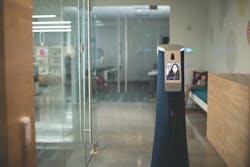How Automation and AI Will Transform the Commercial Real Estate Industry
Automation and AI technology have transformed many industries from healthcare to banking to retail, and while the commercial real estate market was not an early adopter, it is definitely another industry beginning to benefit from this type of disruptive technology for improving efficiency.
The lingering impact of the pandemic, the future of work, the labor shortage and the worsening economy are all factors weighing heavily on property owners who are looking to quickly cut costs or improve asset values. To improve efficiency and reduce labor costs, these owners can leverage automation technology, machine learning and robotics for tasks like facility management, security, inventory and supply management, and even attracting new tenants.
Here are just a few ways that robotics, AI technology and automation will benefit commercial real estate property owners.
1. Data Analysis for Better Property Management
While there’s been a consolidation of commercial real estate and corporate offices following the pandemic, better insight into buildings and occupancy across all of these sites is necessary. Robotics and AI technology could help property managers collect and measure data to determine:
- Which spaces are really being used and which ones aren't. Is it feasible to downsize?
- Employee and visitor check-in. Facial recognition, badge identification or security check-in can tell you who is in the office and who isn't. Who comes frequently? Are there people coming into the buildings who aren’t tenants or visitors? How many visitors do you get?
- Better mapping for entire buildings, using a robot to provide a geospatial layout of an office and the atmospherics, including lighting, sound and environmental conditions (such as temperature) throughout the day.
- Extra services, such as a concierge service where robots can assist with visitor management or navigating the office.
- Office supplies, inventory and food use. With AI technology, managers can predict how many supplies they need, how much food to order and in what locations, based on the number of people who frequent each location.
- Where to beef up security. For example, robots integrated with camera systems could patrol blind spots in your workspace.
- More efficient energy use. Leveraging robots’ cameras and environmental sensors integrated with your HVAC system could allow you to better manage energy usage for employees who are actually in the office.
2. Cost-cutting to Handle Lower Occupancy Rates and Expensive Guard Posts
Following the pandemic and sharp rise in remote and hybrid work-from-home models, there has been lower occupancy rates in corporate offices. Companies are right-sizing their office space and even acquiring satellite offices to accommodate for a changing workforce. While occupancy rates have dropped, facilities management costs have gone up by 6.6% and 7.1% in 2021 and 2022 and are projected to increase by 3.8% in 2023, putting a bigger squeeze on commercial property owners.
But one way they can cut costs quickly is to bring in automation for facility management and security. Corporate offices still need to be maintained properly, and security for both personnel and intellectual property is critical, but all of these tasks do not need to be performed by security guards. Those posts are expensive positions to fill with high turnover. For example, a 24/7/365 guard post is $200,000 to $350,000 per year, and a guard post means five shifts, which includes multiple guards. The annual turnover rate can be as high as 200% because of stress, isolation and monotonous tasks required by the job.
With a robotically delivered Remote Guarding Service, companies can get an annotated picture of their facility for all inspection points of patrol, completing all of the security and facility tasks at a fraction of the cost. This includes checking on door alarms or walking around desks at 3 a.m. checking for PII. By automating these routine, mundane tasks, guards can respond to more serious security issues that require human judgment.
For companies considering a hoteling workspace model, where employees reserve office space in their days in the office, robots can provide concierge and escort service for employees navigating different workspaces.
3. Maintaining Uniformity Across Commercial Properties
For property managers, one of the major marks they need to hit are inspections, and many of these inspections are measuring whether the owner’s sites have the same look and feel across all locations. For example, some property owners want entry into their buildings to be universal across the organization, and the same physical security procedures in place at all offices as well. So if a tenant has a badge at your homebase Los Angeles office, it works in your Boston satellite office as well as your London landing pad.
Building and office uniformity also includes how you handle what areas of the office are open to the public and which are for employees with badges and visitors, as well as how and when you deploy security guards or automated services. Likewise, visitor management should be uniformly handled across offices to ensure consistency down to your smallest landing pad.
Automation technology can make all of these procedures simple to replicate across various offices and building sites.
4. Appealing to Tech-Savvy Tenants
People returning to the offices are now used to having mobile technology at their fingertips and they’re going to look for that same level of convenience when it comes to where they work. This could mean mobile check-in on their devices instead of carrying around security badges, or digital kiosks with maps and information about the building as well as access to immediate customer support. And having smart robots who can escort visitors, perform security checks and ride the elevators is certainly a fun and cool factor for employees to see in their office.
While the commercial real estate market is certainly feeling the effects of a down economy, low occupancy rates and a slow return to the office, property owners can leverage technology innovation to improve overall efficiencies. From streamlining facility maintenance and security tasks to improving inventory management and energy use to replicating uniformity and building access, AI and automation will play an important role in cutting costs and improving the bottom line for commercial property owners.
About the Author:
Mike LeBlanc is the President and Chief Operating Officer of Cobalt.
About the Author

Contributed Author
BUILDINGS partners with industry experts to bring you contributed content covering the hot topics for building owners and facility professionals.
